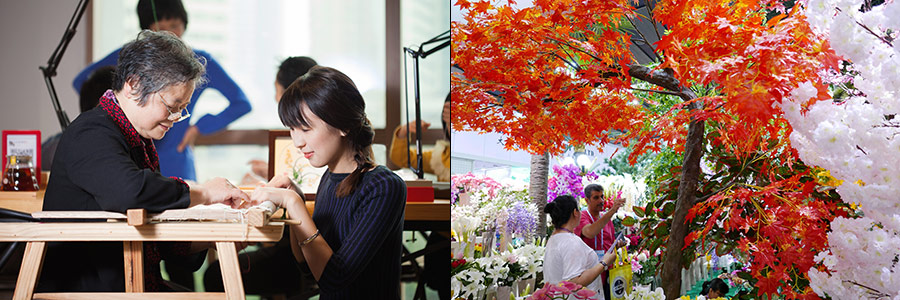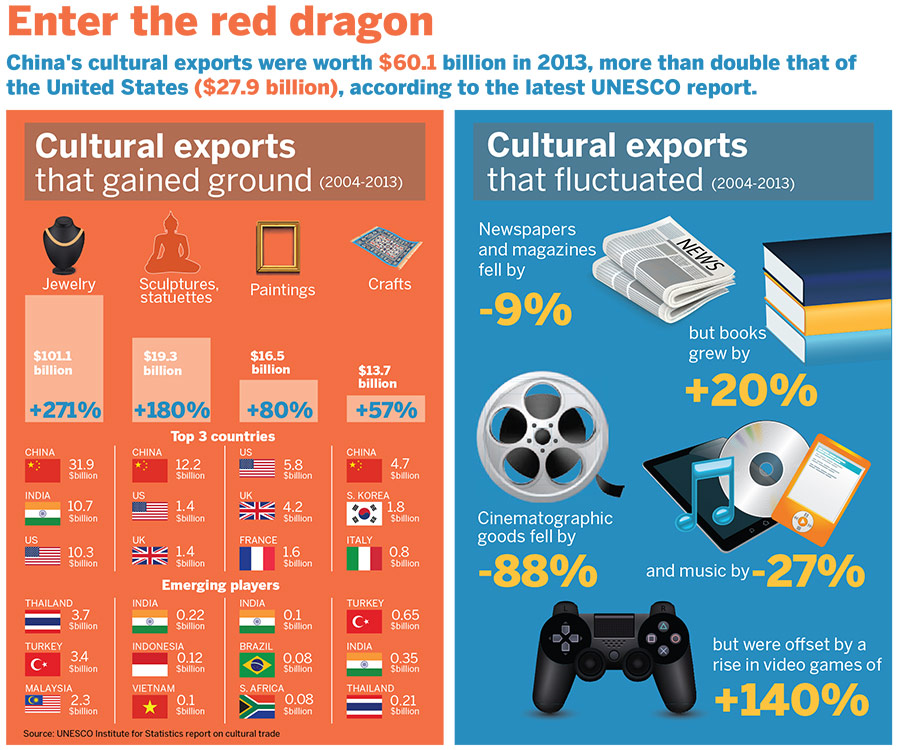In the past few years, China has emerged as the world’s largest cultural goods exporter in value terms.
For instance, in 2013, China exported cultural goods worth $60.1 billion, more than double that of the United States, whose exports were worth $27.9 billion.
But China lacks in domestic brands that can create a profound impact on the global cultural goods market. The scarcity can be attributed to market barriers and late start of the Chinese culture industries, said experts.
China’s main cultural goods and services include gold jewelry, art (statues, paintings), crafts (pottery, chinaware), music, dance, cinematographic products, travel, sports, education, entertainment and handicraft (wood-craft, artisans’ creations, handloom cloth, metal art).
According to data of the Ministry of Culture, the actual consumption level for cultural products and services is around 1 trillion yuan ($154 billion) now. But the potential is there to boost the figure to 4.7 trillion yuan in the near future.

Left: A senior worker teaches her apprentice how to make a Guangdong embroidery (yuexiu) art product at a silk products company in Guangzhou, Guangdong province. Right: A foreign businessman inspects artificial flowers at a recent trade fair in Guangzhou.[Photos/China Daily]
The thirteenth Five-Year Plan (2016-20) has positioned cultural industries as a key pillar of the national economy.
That is in tune with the recent rapid growth in China’s cultural exports, which began in 2009. Within one year, the country overtook the US as the market leader, according to a UNESCO report in March.
Emerging markets like Turkey, India and Malaysia have also emerged as leading exporters of cultural goods.
The US remains the top importer of cultural goods, followed by other advanced economies.
While cultural trade between developed countries has remained strong, that between emerging markets has stayed weak, the report said.
“China lacks major cultural enterprises with brand impact and original designs. A large part of exports of cultural products comes from processing trades, without much independent research and development,” said Lu Jinyong, director of the China Research Center for Foreign Direct Investment at the University of International Business and Economics in Beijing.
“Although the number of domestic cultural companies rose in recent years, the market penetration level is low. This also shows a large gap between China and developed countries. So, you could say China has significant potential for growth.”

Despite the global economic downturn and the advent of online consumption, global trade in cultural goods has doubled from 2004 to 2013, showing the strong resilience of cultural industries.
Gold jewelry, art and crafts, statues and paintings have been the most traded cultural goods globally. In 2013, they accounted for 71 percent of cultural exports, growing from 50 percent in 2004. Trade in recorded music products and cinematographic products has declined.
“(Global) trade in cultural goods totaled $212.8 billion in 2013, nearly double the amount in 2004. This is further evidence of the critical role culture industries play in today’s global economy,” said Silvia Montoya, director of the UNESCO Institute for Statistics.
In 2014, value-added cultural industries accounted for less than 4 percent of China’s GDP, compared with 25 percent in the US, where a stable base facilitates mature growth, unlike in China where the development of cultural industries is marked by many untapped resources.
Nevertheless, some of the well-regarded cultural enterprises in China have achieved significant revenue growth, burnishing their reputation. They have expanded overseas, contributed to worthy causes and fostered innovation.
Huayi Brothers Media Corp, China’s largest private film company, says it will expand its international reach, especially in the US.
After a few failed attempts to co-finance movies with US companies, Huayi directly invested $130 million in 2014 to establish a wholly owned US subsidiary. The arm will produce and distribute movies and TV shows in the US.
Huayi also plans to work with STX Entertainment, a California-based film and TV company, to co-produce 18 films, to be distributed worldwide by 2018.
It is the first such formal agreement between a Chinese company and Hollywood and the first time that a Chinese film company will take proportional profits at the global box office. In recent years, Chinese people have attached importance to spiritual and cultural life. Demand for travel, sports, educational and entertainment services grew.
Global demand for Chinese cultural products may boom in the foreseeable future, if the success of Dynamic Yunnan is any indication.
The company is the country’s first large-scale producer of an original song-and-dance play. The drama is rooted in the traditional exotic Yunnan culture of southwest China.
Dynamic Yunnan has staged performances nationwide and worldwide, especially at popular travel sites. The company’s operations gathered momentum after it went public on the National Equities Exchange and Quotations, also known as the New Third Board, in 2014.
That helped it to attract more investments. The company began to develop related businesses, including sales of cultural products. It even diversified into real estate.
“China has paid much attention to the growth of cultural industries. It has set up a number of cultural industrial parks. The growth of the sector is challenging, given its long and uneasy production cycles. The government should offer more financial support and preferential tax policies to the sector,” Lu said.
“China should create more cultural brands that are rooted in traditional Chinese culture, technique and craftsmanship. The Chinese cultural products have to be unique, and they can’t imitate foreign designs. But the styles and packaging should conform to international trends, and better cater to foreign tastes.
“China can develop more multinational cultural corporations. This will help China to popularize Chinese cultural products worldwide, and promote China’s image and global impact.”
